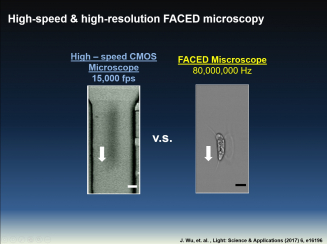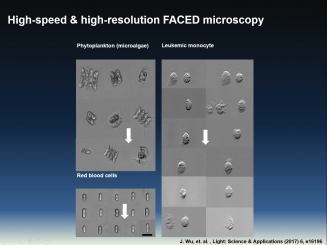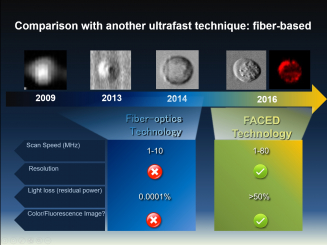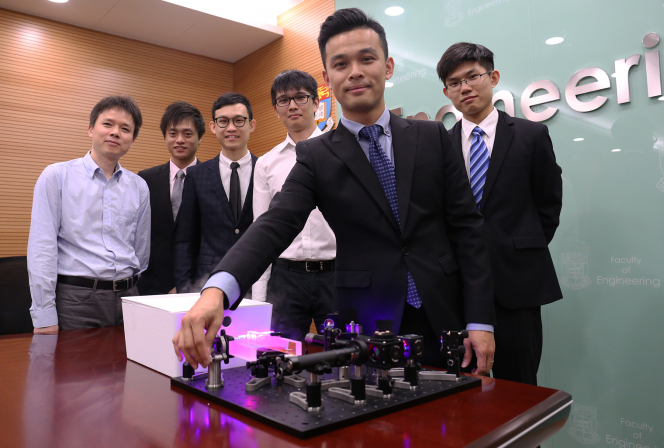Media
HKU scientists achieve breakthrough in laser imaging
100 times faster than existing technology simply with an infinity mirror
24 Apr 2017

The HKU FACED team led by Dr Kevin Tsia (centre) and the laser-scanning device with an infinity mirror
Dr Kevin Tsia, Associate Professor in Department of Electrical and Electronic Engineering at the University of Hong Kong and his research team developed a new laser-scanning imaging technique that overcomes the limitations of existing technologies, providing more than 100 times faster in scan speed with high image resolution.
Laser-scanning imaging is the workhorse widespread in many applications, ranging from routine optical microscopy in scientific research (e.g. biology, material science) and biomedical diagnosis to machine vision in industrial manufacturing processes.
The new technique not only can resolve the current challenge to meet the ever-increasing demand for speed and throughput, but could also empower new discovery in basic scientific research, with potential applications in a new generation of biomedical microscopy for precise and early diagnosis of diseases.
The work was published in Light: Science and Applications in January 2017.
Dubbed free-space angular-chirp-enhanced delay (FACED) imaging, at the heart of the innovative technique is the “infinity mirror” – a pair of parallel mirrors. Researchers applied this “device” with a subtle twist (~ 0.01 degree). They combine ultrafast pulsed laser and a “tilted” mirror-pair to create an ultrafast sweeping laser beam. The pulsed beamlets are projected onto different positions at different arrival times and behave as a scanning optical beam.
“Notably, being 100 times faster in imaging speed than state-of-the-art imaging flow cytometers without losing the image information content, this technology could be an effective and efficient tool to analyse individual cells, e.g. cancer cells, in great details within an enormous population of cells,” said Dr Kevin Tsia.
Combining FACED imaging with microfluidic technology, the team demonstrated high-resolution and high-throughput single-cell imaging at 10,000 to 100 000 cells per second, which is almost 100 times faster than current microscopy. Such a high throughput imaging could be particularly beneficial for cancer diagnosis by providing an effective and efficient method to detect rare cancer cells in a pool of billions of blood cells.
“It opens new potentials where high-speed and high-throughput biological microscopy are needed but were once out of reach. They are ultrahigh-throughput whole-slide imaging for digital histopathology, large-scale microalgae screening for harmful algal bloom monitoring in marine biology study. The technology can also be applied to high-speed cellular dynamics monitoring, for example, neuronal firing for studying complex brain functions and diseases including brain degeneration like Alzheimer or brain disorder,” he added.
“Current standards of laser scanning are predominantly based on mechanical scanning mirrors to steer the laser beam direction. But, their scanning speed are inherently limited by mechanical inertia and can only reach up to about 10-100kHz,” explained by Dr Wu Jianglai the postdoctoral researcher of the work, adding: “the beam scanning action of FACED is in contrast done without any moving parts and its speed is simply governed by the flashing rate of the pulsed laser, which could easily be MHz and above achieved by current laser technology.”
The team has been working on laser imaging development using another technology based on optical fibre. However, there is a major limitation - more than 99.999% of the light is lost during propagation in fibre. Aiming to resolve this problem that hampers its adoption in optical microscopy applications, the team started to switch their focus to investigating light propagation simply in free-space 2 years ago. They soon discovered that misaligning the “infinity mirror” with a tiny angle, which is seemingly undesirable in standard optical system design, but interestingly results in a set of unique light trajectories (beamlets) that can be harnessed for ultrafast laser-scanning action, and thus imaging without significant power loss.
Dr Tsia said the team’s next challenge will be to deal with the unprecedentedly huge amount of image data analysing them to provide useful information. He added that artificial intelligence could play a role in such case.
A US patent has been pending for the new technology.
In addition, Dr Tsia has recently received the 14th Chinese Science and Technology Award for Young Scientists in 2016. The award aims at granting recognition to young scientists in China with exceptional accomplishments in the areas of natural science research, engineering technology or technology transfer. Out of the 98 awardees, Dr Tsia is one of the only two awardees from Hong Kong, out of the 98 awardees nationwide.
The Science and Technology Award was initiated by former President of China Association for Science and Technology Professor Qian Xuesen in 1987. Awards are given every two years to no more than 100 young scientists. Since 2011, HKSAR young scientists have been incorporated for nominations under the scheme. As of 2016, four awardees were from Hong Kong.
For a short demonstration video on the new laser-scanning technique, please visit (with subtitles):
www.cpao.hku.hk/media/faced-with-subtitles.mov
For a short demonstration video on the new laser-scanning technique, please visit (without subtitles):
www.cpao.hku.hk/media/faced-no-subtitles.mov
For media enquiries, please contact Ms Melanie Wan (Senior Manager (Media), Communications and Public Affairs Office) tel: 2859 2600 / email: melwkwan@hku.hk; or Ms Esther Lau, Faculty of Engineering, HKU, tel: 3917 1924 / email: estherlc@hku.hk.





